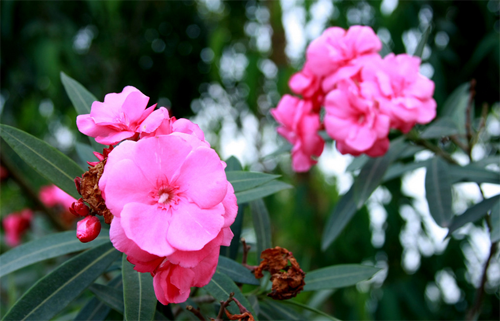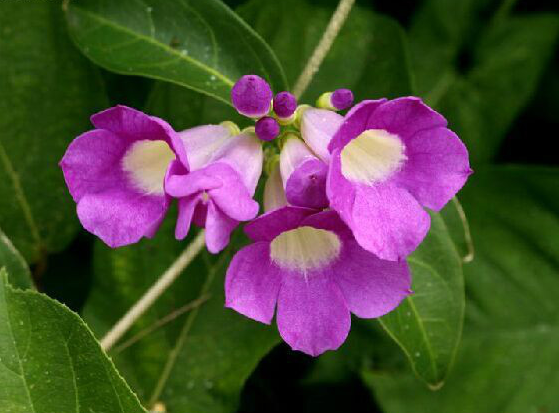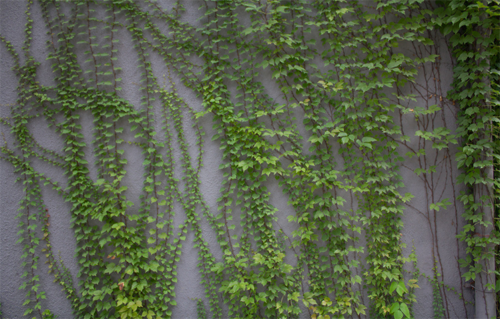Is the culture method of oleander poisonous?
Oleander is very good-looking, open flowers are pink, is very good-looking, many people are very fond of raising, oleander breeding method is what kind of it? Is oleander poisonous?

The cultivation method of oleander:
1. Planting
In the north, oleander is planted, usually in the middle and late April. Change pots before leaving the room (can change pots once every 2-3 years), and cut off rotten roots and over-dense roots when changing pots. The pot soil can be prepared by mixing 5 parts of garden soil, 4 parts of sandy soil and 1 part of cake fertilizer, or 4 parts of rotten leaf soil, 2 parts of garden soil, 2 parts of decomposed manure soil and 2 parts of sandy soil, and bone powder is put into the pot bottom as base fertilizer. After changing pots, irrigate with water and ventilate to cultivate in sunny place.
2. Fertilization
Oleander love fertilizer, from the room to the flower fade (frost) can be applied every 20 days or so 1 thin liquid fertilizer. After the beginning of autumn oleander rapid growth, then every 15 days or so can be applied 1 fertilizer until before entering the house.
3. Watering
Although oleander likes water but afraid of waterlogging, even rainy days should be dumped in time basin water, in case of rotten roots. Too much watering, the leaves will fall off yellow, affecting the flowering of the following year. Spring and autumn season watering should see dry see wet, in order to keep the pot soil moist is appropriate.
Summer is the period of vigorous growth and flowering of oleander, so it needs more water. It is advisable to irrigate water once a day in the morning and evening, and pay attention to spraying branches and leaves frequently to keep the leaves fresh and green. In the middle of October, after entering the room, control watering, avoid excessive water, otherwise easy to rot roots, leaves, affect the growth of the next year.
4, temperature, light
Oleander like sunshine, so during the growth period need to be placed in a sunny place maintenance, otherwise less flowers pale color.
Winter room temperature is not lower than O℃ can be, temperature is too high, consumption of nutrients, the second year of growth and flowering adverse.
5. Shaping and pruning
Oleander leaves 3 whorls, is a typical three-branched branches, every pruning 1 that is, from the stem node to give birth to 3 new branches. People often use this branching characteristic of it to carry out shaping and pruning, so that it becomes 3 main branches on each trunk, and 3 branches on each main branch, which is commonly known as the "three-branched nine-top" tree.
After potted oleander survives, the first pruning can generally be based on plant height and personal preference, leaving 30-40 cm of trunk to top and promote its lateral branches to germinate. When the new branches grow to 4-6 cm long, select 3 appropriate strong branches in the basin, and wipe out the rest. At this time, fertilizer and water management should be strengthened.
The second pruning depends on the growth of the plant, it should be carried out in July, each lateral branch leaves 10-15 cm to top, and 3 branches are selected on the lateral branches. After such pruning, it becomes the favorite "three-branched nine-top" tree.
After pruning, it can be planted in summer and transplanted into flowerpots in autumn. In this way, when the flowers are full in the second year, the flowers are evenly distributed and the crown is neat and beautiful.
6, reproduction
Oleander flowering often does not bear fruit, so commonly used cutting propagation. Hardwood cutting time in early April, softwood cutting should be carried out in June-July.
Cut healthy annual branches into 15-20 cm long stem segments, cut off the upper leaves, first put them into clear water for root promotion, the water depth reaches 1/3 of the cuttings, and change the clear water every 2 days; immerse them in water for about 10 days, and insert them into plain sand when small white spots appear on the soaked skin. Roots can be rooted in about half a month, and they can be transplanted after 1 month.
Is oleander poisonous?
Oleander is one of the most poisonous plants. Its stems, leaves and flowers are poisonous and contain a variety of toxins, some deadly. It secretes a milky juice containing a toxic substance called oleander, ingestion will be toxic, so stems and leaves can be made pesticides.
Due to its toxicity, oleander should not be cultivated indoors, especially in pregnant women and families with young children.
Oleander florescence:
Oleander leaves such as willow bamboo, safflower burning, better than peach blossom, now white, yellow, red and other varieties, there are special aroma, long flowering period, for 6~ October, is a famous ornamental flowers.
Oleander breeding methods are introduced here, oleander is toxic, pregnant women do not breed at home.
oleander-oleander pictures| Is oleander poisonous?| Oleander cultivation method oleander, Latin scientific name for Nerium indicum Mill, also known as willow peach, half a year red, A peach, etc., originated in India, Iran and Afghanistan, cultivated in China has a long history, throughout the north and south urban and rural areas. Oleander likes plenty of light, warm and humid climate conditions. The colors are red and white. Cultivation method of oleander
1. Watering: Although oleander likes water, it is afraid of waterlogging. In case of continuous rainy days, the accumulated water in the basin should be dumped in time to prevent rotten roots. Too much watering, the leaves will fall off yellow, affecting the flowering of the following year. Spring and autumn season watering should see dry see wet, in order to keep the pot soil moist is appropriate. Summer is the period of vigorous growth and flowering of oleander, so it needs more water. It is advisable to irrigate water once a day in the morning and evening, and pay attention to spraying branches and leaves frequently to keep the leaves fresh and green. In mid-October, after entering the room, control watering, avoid excessive water, otherwise easy to rot roots, leaves, affect the growth of the next year.
2. Light: oleander likes sunshine, so it needs to be maintained in a sunny place during its growth, otherwise it will have less color.
3. Temperature: oleander should be planted in leeward and sunny places. In winter, people should freeze indoors. The room temperature should not be lower than O℃. If the temperature is too high, nutrients will be consumed, which will be unfavorable for the growth and flowering of the second year. If the outdoor temperature is high in winter, soil can be cultivated to keep warm.
Is oleander poisonous?
Is oleander poisonous? Oleander whole plant is highly toxic, poisoning symptoms are **, vomiting, lethargy, arrhythmia, serious words even lose consciousness or death are possible, so the face of oleander, as long as you appreciate it, do not start oh!
When do the flowers bloom?
Native to India and Iran, it is now widely cultivated in subtropical and tropical regions. Introduction began in the Song and Yuan Dynasties, and all provinces and regions have cultivated it. Like light, like warm and humid climate, not cold, avoid water damage, resistant to a certain degree of air dryness. Suitable for good drainage, fertile neutral soil, slightly acidic, slightly alkaline earth can also adapt. Oleander has a strong ability to absorb dusts and toxic gases
Flower language of oleander
Peach oleander flower language: curse, beware of danger;
Yellow oleander flower language: deep friendship.
The Legend of Oleander
Princess fell in love with his vassal, due to family opposition, the fragile princess chose and his sweetheart with the fate of favoritism. She had always naively believed that her lover would definitely be with her forever, but she only thought so. Her vassals did not really like her, but only played this role for her own benefit. The sad princess committed suicide under the oleander. Only her own blood soaked the flowers, and the oleander blossomed pink and white.
Zhang Yueran's "Narcissus has gone by carp" describes oleander_--the heroine Jing's favorite flower, she lives in the house of Tao Li Street full of this kind of flower, perhaps it is hinting Jing's hatred for Man. The flower symbolizes revenge, symbolizes Jing's determination and perseverance.
Characteristics of oleander
1, morphological characteristics: evergreen large shrubs, up to 5 meters high, glabrous. Leaves 3-4 in whorls, opposite on lower branches, narrowly lanceolate, entire, leathery, 11-15 cm long, 2-2.5 cm wide, pale green below; lateral veins flattened, densely parallel. Summer flowering, flowers pink or white, in terminal cymes; calyx erect; corolla crimson, aromatic, double; corona scalelike, apex torn. Follicles orbicular, 10-23 cm long, 1.5-2 cm in diam.; seeds apically with yellow-brown seed hairs. Stems erect, smooth, typically trifurcate. 3-whorled, rarely 4-whorled and 2-foliolate opposite, linear-lanceolate to oblong-lanceolate, entire, leathery, leaf surface shiny, lateral veins pinnate. Cymes terminal, corolla funnel-shaped, red, yellow, white three kinds, single valve, semi-double valve or double valve, there is fragrance, long cylindrical pod. Flowering from June to October, fruiting from December to January. Common cultivated varieties are: white oleander, white flowers, single petals; double petals oleander, red flowers double petals; yellow oleander, flowers light **, single petals. The whole plant of oleander is highly toxic.
2, growth characteristics: like light, like warm, humid climate, not cold; drought resistance, not strict with the soil requirements, can also grow on alkaline soil.
The role of oleander
The role of oleander: 1, viewing. Oleander leaves such as willow bamboo, red burning, better than peach blossom, corolla pink to red or white, with special fragrance, flowering for 6~10 months, is a famous ornamental flowers.
The role of oleander: 2, purify the air. Oleander has anti-smoke, anti-dust, anti-poison and purification of air, environmental protection capabilities. Oleander leaves, toxic to the human body, sulfur dioxide, carbon dioxide, hydrogen fluoride, chlorine and other harmful gases have a strong resistance. According to the determination, potted oleander, 40 meters away from the pollution source, only slightly damaged, 170 meters is basically harmless, still can bloom normally, the sulfur content of its leaves is more than 7 times higher than that of unpolluted. Oleander even if the whole body is covered with dust, still can grow vigorously, known as "environmental protection guards."
Medicinal value of oleander
Oleander is the leaf of oleander, a bamboo-family plant. This product belongs to cardiotonic Chinese medicine. bitter taste, cold nature, poisonous, heart meridian. The main function is to strengthen the heart diuretic, expectorant asthma, analgesic, blood stasis. Modern clinical application of this drug for heart failure, asthma cough, epilepsy, traumatic injury, amenorrhea, alopecia areata. cardiotonic action, diuretic action, sedative action, pest control action, etc.
Related encyclopedias
Pocket scale non-woven bag lamp grass bamboo shoots crab feet red rice note3ykk zipper ybs zipper mountain cherry climbing wall plum wild cassia winter plum pine watch Omega Longines famous watch children's building blocks flint azalea orchid roll stick thorn fruit Annona
Oleander cultivation methods, oleander poisonous, oleander picture appreciation!
Oleander flower stems like bamboo, flowers like peach, and get this name. Oleander flowers suitable for growth in warm subtropical regions, originating in India, Iran and Afghanistan, China introduced in the 15th century, cultivation has a long history. Oleander flowers are beautiful and fragrant, widely cultivated for ornamental purposes, and it is also an excellent Chinese herbal medicine plant. Today, we will briefly introduce the cultivation methods of oleander and oleander poisonous. Cultivation method of oleander Oleander likes sunny, warm and humid environment, although not cold, but strong adaptability. In central China, East China can be cultivated in the open field. Oleander on the soil requirements are not strict, slightly acid, slightly alkaline soil can adapt, but loose and fertile soil is appropriate. Potted oleander is best mixed with 3 into decayed leaf soil or 3 into compost soil, 3 into dung dry soil and 4 into sandy soil. oleander grows fast and should be removed from the outdoor basin in late April every year. In addition to replacing the pot soil, a small amount of hoof horn should be applied as base fertilizer, and the potted oleander should be removed outdoors. When the flower withers in September and October, the fermented sesame sauce residue dry fertilizer should be applied once a month. The amount of fertilizer can be determined according to the size of the flowerpot, such as 50 grams for 20 cm pots and 200 grams for 50 cm pots. Oleander watering follow the principle of watering thoroughly when it is dry. If the soil in the pot is too dry and the leaves have wilted, you should first irrigate a small amount of water, and then irrigate thoroughly after the leaves slow down. Potted oleander should be shaped and pruned once a year. When pruning, 3 main branches are generally reserved on each trunk, and 3 branches are reserved on each main branch. Each branch should be cut 20-30 cm from the base, which is often used in the "three branches and nine tops" shaping pruning method, this method will also make its flowering head. Oleander propagation easy, spring and summer can be cuttage, cuttings without leaves, can also be used for high temperature and high humidity air propagation, rooting easier. Is oleander poisonous? The whole plant of oleander flower contains poison, even after drying, there are still toxins, so it can be said that it is one of the most poisonous plants, containing a variety of toxins, some are even fatal. If you accidentally eat oleander flowers caused poisoning, nausea, vomiting, lethargy, arrhythmia and other symptoms, serious or even death. Someone once used oleander flower branches as chopsticks, resulting in poisoning caused by eating toxic sap in the branches. In Hong Kong, there have also been cases of death caused by mixing cooked food or porridge with oleander branches. So for oleander flowers it is best not to touch them, but to appreciate their beauty from afar. Legend of oleander Legend has it that in ancient times, a beautiful girl called peach, she fell in love with a strong character called bamboo long-term guy. Because of his father's personal opinion, Zhu was beaten to death. Bamboo died, peach also followed for his beloved people died. When their souls to heaven, God moved for their true feelings, promised to meet their one request, peach said she loved the purity of peach blossom all her life, but bamboo hopes to retain his tenacity like bamboo. Thus, the world produced a bamboo-like leaves, open like peach plants-oleander.
- Prev

The cultivation method and reproduction of garlic vine do you want to lose the leaves in winter?
Garlic vine is not generally good-looking, but also can climb the wall, garlic vine flowers are also particularly good-looking, just like a blossom of small trumpet flowers, what are the breeding methods of garlic vine? How do you reproduce? Do you want to lose the leaves in winter? The cultivation method of garlic vine: light and temperature, garlic vine likes light.
- Next

How does Parthenocissus grow and reproduce? what's the alias?
As long as Parthenocissus is planted on the wall, the whole wall may be covered, and the whole house looks like a forest, forming a natural barrier for the house. How can Parthenocissus be planted? What is the method of reproduction? What other aliases are there?
Related
- Fuxing push coffee new agricultural production and marketing class: lack of small-scale processing plants
- Jujube rice field leisure farm deep ploughing Yilan for five years to create a space for organic food and play
- Nongyu Farm-A trial of organic papaya for brave women with advanced technology
- Four points for attention in the prevention and control of diseases and insect pests of edible fungi
- How to add nutrient solution to Edible Fungi
- Is there any good way to control edible fungus mites?
- Open Inoculation Technology of Edible Fungi
- Is there any clever way to use fertilizer for edible fungus in winter?
- What agents are used to kill the pathogens of edible fungi in the mushroom shed?
- Rapid drying of Edible Fungi

